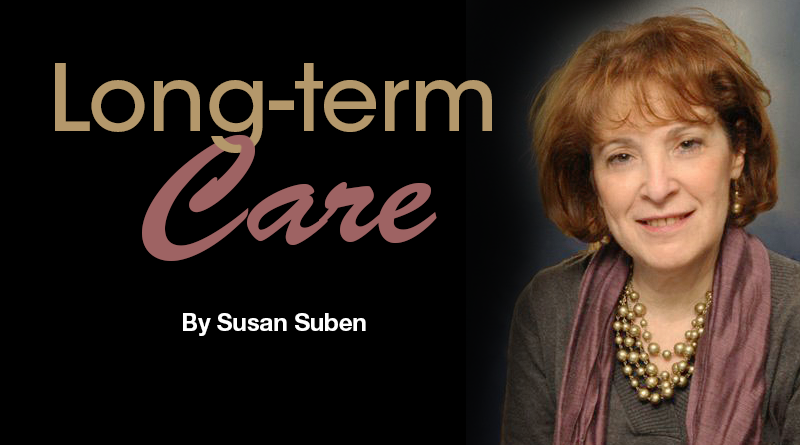LTC Planning: Good Things Are Sometimes Hard To Do
By Susan Suben
 I have clients calling me all the time saying they are thinking about long-term care planning but they don’t know what to do and maybe they’re too young to do anything.
I have clients calling me all the time saying they are thinking about long-term care planning but they don’t know what to do and maybe they’re too young to do anything.
I’ll address the last quandary first. No one is ever too young to plan for LTC because we don’t know what the future holds. The average age of someone contemplating and planning for this risk is about 59 yet I am working with clients in their 30s. The reason for the downward age shift is that many younger people are seeing their parents or grandparents deal with a LTC illness and they are concerned about being able to take care of themselves. Also, the older you are, the fewer strategies to choose from and they will be more expensive.
There is no arguing that LTC planning is complicated, intimidating and overwhelming. There are so many options to learn about: LTC insurance, life insurance policies with LTC or chronic illness riders, wealth replacement strategies, and irrevocable trusts.
Planning for LTC is one piece of an overall retirement plan and a team effort. You should seek advice from an estates and trust or elder law attorney along with recommendations from your financial adviser and accountant.
Whatever you do, don’t listen to anyone who tells you that you don’t need a plan. Will they come up with $144,000 a year for your nursing home care, make sure that the standard of living of your spouse/partner is not diminished if assets are spent for LTC or leave a legacy for your family? Planning is essential. Your health insurance will not pay for LTC — and Medicare reimbursements are limited and Medicaid requires that you spend your assets down to be eligible.
‘Whatever you do, don’t listen to anyone who tells you that you don’t need a plan.’
Do the math. If you were in a nursing home paying $12,000 per month for three years, your total expense would be $432,000. For five years, it would be $720,000. In an assisted living facility, it would cost approximately $180,000 for three years based on $5,000 a month or $300,000 for five years. Home care costs about $25 an hour. If you had eight hours of care per day for three years, your out-of-pocket expenses would be $218,400.
So what can you do? Let’s look at a few of the strategies named above.
A Medicaid Irrevocable Trust allows you to shelter your assets from a Medicaid spend-down. Medicaid requires that your assets be in a trust for five years before you can apply for Medicaid in order to avoid a penalty period. This type of strategy should be considered if you have a substantial amount of unqualified money (stocks, bonds, etc.) or real estate (your home, vacation home or rental property). Qualified funds such as pensions and IRAs cannot be placed in a trust.
The simplest approach to planning for LTC is still a LTC insurance policy. These policies offer the most robust benefits and ease of design. You can select a NYS Partnership plan if you would like to ensure total or partial asset protection or a traditional policy that has more riders, enhancements and couples’ benefits.
LTC insurance will help you stay out of a nursing home. You can gear the benefits toward home care and assisted living. If your estate is mostly comprised of qualified money, once it is in payment status, it is not susceptible to a Medicaid spend-down should you enter a nursing home. Most individuals are staying at home for as long as possible. Consider placing your house in an irrevocable trust and purchase a LTC insurance policy geared toward home care. The premium will be much more reasonable.
Reposition your assets by purchasing a life insurance policy with a LTC component known as a hybrid. You can leverage the death benefit with a rider to pay for your LTC expenses. If you never need LTC, your family will inherit the death benefit tax free. It’s a win-win strategy.
A fourth option would be wealth replacement in the event assets are spent on LTC. For example, Mary is 65 years old and in good health. She transfers $75,000 into a single premium life insurance policy that buys her a death benefit of $221,782 and then transfers her policy out of her name. She leveraged her $75,000 preserving a legacy for her family and replacing the funds she might spend on LTC. This strategy does require satisfying the five year lookback period for transferring ownership of the policy.
The best way to get on the right LTC planning path is to mark off the strategies that don’t interest you or are not in your best interest. Work with a professional team. Good things are sometimes hard to accomplish. LTC planning is a good thing even though it initially may be hard to do.
Susan Suben, MS, CSA, is president of Long Term Care Associates, Inc. and Elder Care Planning. She is a consultant for Canandaigua National Bank & Trust Company. Contact her at 800-422-2655 or by email at susansuben@31greenbush.com. Ideas for this article came from Sheila Cevera’s presentation, Alternative Solutions for Long Term Care.

